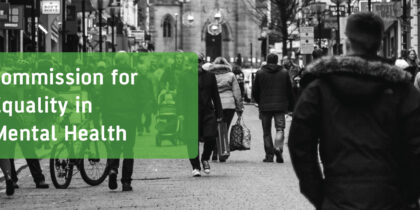Last week saw the publication of what could be a landmark report in the recent history of the NHS in England. Lord Darzi’s investigation, commissioned by the new Government, laid bare the current challenges, and some of the strengths, of the NHS at the current time. It was produced as a precursor to a proposed ten-year plan for the NHS next spring. So its findings and conclusions will have a major bearing on the priorities for that plan, which will likely determine the levels of investment and therefore ambition in mental health services for the decade to come.
The report pulls no punches. It describes, sometimes in graphic detail, the shortcomings of the NHS today, as well as setting out ways in which the public’s health has been declining over recent years and what this has meant both for us as people and for our health care system.
Unusually for a report covering the whole spectrum of health care, it includes quite a lot of detail about NHS mental health services. After a decade of fighting for the realisation of the warm words of ‘parity of esteem’ for mental health, it’s perhaps a small sign that the battle is not lost, albeit an ongoing work in progress. The report rightly notes where investment in mental health services can make a difference, and gives some examples of where expansion is working. But it also notes some very serious gaps and shortcomings. Perhaps most strikingly, the report speaks about the poor conditions on many mental health inpatient wards, at times using language that borders on stigmatising to make the point about the unacceptably poor environments mental health care continues to be delivered in in 2024.
The report also identifies the problem of mental health service waiting lists, which now include one million people in England: “Long waits [for mental health services] have become normalised: there were 345,000 referrals where people are waiting more than a year for first contact with mental health services— a figure higher than the entire population of Leicester.” The relative invisibility of mental health service waiting lists compared to those for other services remains a basic inequity in a health care system where long waits seem to be endemic, and yet some are still given greater priority than others. Parity of urgency, with equal accountability, is necessary so that we stop treating these long waits as inevitable and unavoidable.
Inequalities in both health and mental health are noted throughout the Darzi report, including the disproportionately coercive treatment of Black and other racialised communities in mental health services and the shortened life expectancy of people with a mental illness. The longstanding and entrenched causes of these injustices are not explored in the text, however, and as a result it gives little direction to policymakers who might want to address them meaningfully. Without this understanding, there is a risk that health policies and services repeat the pattern of overlooking inequality and miss the mark in closing these shocking gaps.
From the perspective of mental health services, nothing the report exposes is new or surprising. Parts of the report do, however, try to look at what is behind the problems it describes. That’s where it gets really interesting. It notes, for example, that:
“There is a fundamental problem in the distribution of resources between mental health and physical health. Mental health accounts for more than 20 per cent of the disease burden but less than 10 per cent of NHS expenditure. This is not new. But the combination of chronic underspending with low productivity results in a treatment gap that affects nearly every family and all communities across the country.”
This will be frustratingly familiar to anyone who has worked in the mental health system or used mental health services at any time in the last decade. Putting it right is of course a bigger challenge. The Mental Health Investment Standard has, over recent years, protected NHS mental health care budgets locally and enabled its proportion of NHS spending to remain steady. But it hasn’t (and wasn’t designed to) bring about a decisive and lasting shift in investment. The report has some well-chosen words on this point:
“General practice, mental health and community services will need to expand and adapt to the needs of those with long-term conditions whose prevalence is growing rapidly as the population age. Financial flows must lock-in this change irreversibly or it will not happen.”
That sets a challenge to government and the NHS. If we are serious about changing the balance of our health care system towards prevention, towards community-based services, and towards mental health, what is going to ‘lock-in this change irreversibly’? Quick-fixes and tokenistic initiatives will not make the necessary impact on a system that’s designed to do more of the same year on year. A meaningful and sustained shift is going to need something different.
The report’s analysis of the system as a whole can be applied to mental health care itself, too. We spend precious little on protecting the public’s mental wellbeing or preventing mental ill health. Late intervention is too often the norm. And while most mental health care is provided in community settings, half of the money spent by the NHS on mental health services goes on hospital-based care. The results of this are predictable enough: people are unable to get help until they reach crisis point, then requiring more intensive and sometimes coercive care, with major impacts on their life and family, at a high cost both to them and to the NHS. This, too, requires a different approach to get different results.
The Darzi report looks beyond the NHS to understand and put its challenges in context. It explores how the nation’s health has deteriorated over recent years, finding that the biggest increases in ill health have been in mental health, especially depression. This is something we have observed for some years, leading not only to higher levels of illness for people but rapidly rising demand for mental health support and higher economic and social costs. At the same time, the report notes that spending on public health services has shrunk. And as mental health protection has been a small part of a diminishing resource, it’s not surprising that local councils’ capacity to address the overwhelming social and economic determinants of mental ill health has been so limited in recent years. Resourcing public health services adequately to turn this around is essential, and cannot wait.
Every report on the state of the NHS eventually looks at social care to understand what’s going wrong. Too often seen as an adjunct to the NHS, only noticed when people are unable to leave hospital beds for lack of support at home, social services are given short shrift time and again. This report to some extent follows the same pattern. It acknowledges that austerity policies have diminished social care over recent years, without really looking at the longstanding disparity between the NHS and social services that’s been with us since 1948.
A new ten-year NHS plan is a chance for a new start. As ever, the biggest problem is that we can’t start afresh with a clean slate. We have to begin with what we’ve got, with all of its inadequacies, biases, and struggles.
The good news is that we have a National Health Service, tax-funded and (mostly) free at the point of use. The Darzi report is clear that this is not simply a matter of principle, it’s also good value for money and makes sense for the long-term. But it’s a service that exists in a society which is becoming more unwell, and that, as the recent Good Childhood Report emphasised, is continuing to undermine children’s health and wellbeing year on year.
A new start for the NHS therefore needs a new start for health, too, with a whole-of-government approach to address the determinants robustly and at scale. And the NHS itself is going to have to change. Not with another structural reorganisation but with real change in the way it works for and with people. That means real co-working with local government and communities. It means updating the estate that makes it next to impossible to provide decent care. It means addressing racism and discrimination at every level of the system. And it means building a workforce that’s diverse, well-supported, and given the time to care.









